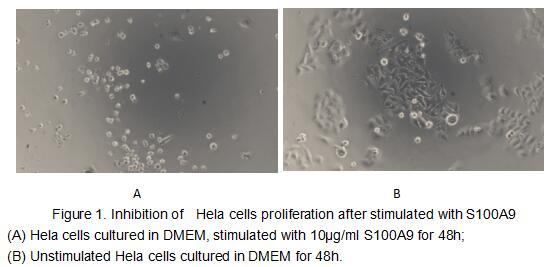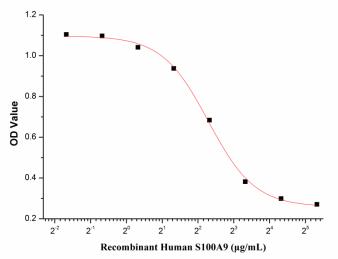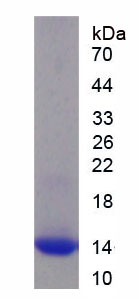Active S100 Calcium Binding Protein A9 (S100A9) 

MRP14; MIF; 60B8AG; CFAG; NIF; CAGB; CGLB; L1AG; P14; Calgranulin B; Migration inhibitory factor-related protein 14; Calprotectin L1H subunit; Leukocyte L1 complex heavy chain
- UOM
- FOB US$ 230.00 US$ 576.00 US$ 1,152.00 US$ 3,456.00 US$ 8,640.00
- Quantity
Overview
Properties
- Product No.APB793Hu01
- Organism SpeciesHomo sapiens (Human) Same name, Different species.
- ApplicationsCell culture; Activity Assays.
Research use only - DownloadInstruction Manual
- CategoryTumor immunityInfection immunityRheumatology
- Buffer FormulationPBS, pH7.4, containing 0.01% SKL, 5% Trehalose.
- Traits Freeze-dried powder, Purity > 95%
- Isoelectric Pointn/a
Sign into your account
Share a new citation as an author
Upload your experimental result
Review

Contact us
Please fill in the blank.
Activity test

S100 calcium-binding protein 9 (S100A9) also known as calgranulin B, is a member of the S100 family of secreted calcium binding proteins containing 2 EF-hand calcium-binding motifs.S100 proteins are localized in the cytoplasm and/or nucleus of a wide range of cells, and involved in the regulation of a number of cellular processes such as cell cycle progression and differentiation. Besides, it has been reported that S100A9 can inhibit Hela cells proliferation. To test the effect of S100A9 on cell apoptosis, Hela cells were seeded into 96-well plates at a density of 4,000 cells/well with 1% serum standard DMEM including various concentrations of recombinant human S100A9. After incubated for 48h, cells were observed by inverted microscope and cell proliferation was measured by Cell Counting Kit-8 (CCK-8). Briefly, 10µl of CCK-8 solution was added to each well of the plate, then the absorbance at 450nm was measured using a microplate reader after incubating the plate for 1h at 37℃. Proliferation of Hela cells after incubation with S100A9 for 48h observed by inverted microscope was shown in Figure 1. Cell viability was assessed by CCK-8 (Cell Counting Kit-8 ) assay after incubation with recombinant human S100A9 for 48h. The result was shown in Figure 2. It was obvious that S100A9 significantly inhibit cell viability of Hela cells. The ED50 is 4.8μg/mL.

Figure 2. Inhibition of Hela cells proliferation after stimulated with S100A9.
Usage
Reconstitute in 10mM PBS (pH7.4) to a concentration of 0.1-1.0 mg/mL. Do not vortex.
Storage
Avoid repeated freeze/thaw cycles. Store at 2-8°C for one month. Aliquot and store at -80°C for 12 months.
Stability
The thermal stability is described by the loss rate. The loss rate was determined by accelerated thermal degradation test, that is, incubate the protein at 37°C for 48h, and no obvious degradation and precipitation were observed. The loss rate is less than 5% within the expiration date under appropriate storage condition.
Increment services
-
 BCA Protein Quantification Kit
BCA Protein Quantification Kit
-
 Molecular Mass Marker for Protein
Molecular Mass Marker for Protein
-
 Monoclonal Antibody Customized Service
Monoclonal Antibody Customized Service
-
 Polyclonal Antibody Customized Service
Polyclonal Antibody Customized Service
-
 Protein Activity Test Experiment Service
Protein Activity Test Experiment Service
-
 Electrophoretic Mobility Shift Assay (EMSA) Experiment Service
Electrophoretic Mobility Shift Assay (EMSA) Experiment Service
-
 Buffer
Buffer
-
 Lentivirus Packaging Experiment Service
Lentivirus Packaging Experiment Service
-
 Adenovirus Packaging Experiment Service
Adenovirus Packaging Experiment Service
-
 Real Time PCR Experimental Service
Real Time PCR Experimental Service
-
 Spike RBD Protein (S-RBD)
Spike RBD Protein (S-RBD)
-
 Protein G
Protein G
-
 Protein A
Protein A
Citations
- Differential Proteomic Analysis Distinguishes Tissue Repair Biomarker Signatures in Wound Exudates Obtained from Normal Healing and Chronic WoundsPubmed: source
- High circulating levels of S100A8/A9 complex (calprotectin) in male Japanese with abdominal adiposity and dysregulated expression of S100A8 and S100A9 in adipose tissues of obese miceScienceDirect: S0006291X1200352X
- Proteins with Altered Levels in Plasma from Glioblastoma Patients as Revealed by iTRAQ-Based Quantitative Proteomic AnalysisPubMed: 23029420
- Identifizierung neuer potentieller Biomarker für das Kolonkarzinom sowie dessen VorstufenInfo:Source
- Susceptibility to COPD: Differential Proteomic Profiling after Acute SmokingPubmed:25036363
- Soluble receptor for advanced glycation end products inhibits disease progression in autosomal dominant polycystic kidney disease by down-regulating cell proliferationPubMed: 25934702
- S100A9 and ORM1 serve as predictors of therapeutic response and prognostic factors in advanced extranodal NK/T cell lymphoma patients treated with pegaspargase/gemcitabinepmc:PMC4810364
- Proteomics Analysis of Blood Serums from Alzheimer's Disease Patients Using iTRAQ LabelingTechnology.pubmed:27911324
- Immune Modulating Topical S100A8/A9 Inhibits Growth of Pseudomonas aeruginosa and Mitigates Biofilm Infection in Chronic Wounds.pubmed:28672877
- Tu1938-Micronutrients Assessment in Patients with Cirrhosis10.1016:S0016-5085(18)33544-3
- Tu1942-PI3K/AKT-Mediated Upregulation of C7 Inhibits Colorectal Cancer Proliferation and Metastasis10.1016:S0016-5085(18)33544-5
- Signaling between pancreatic β-cells and macrophages via S100 calcium-binding protein A8 exacerbates β-cell apoptosis and islet inflammationPubmed:29496993
- The role of calgranulin B gene on the biological behavior of squamous cervical cancer in vitro and in vivoPubmed:29497331
- S100A8/A9 promotes MMP-9 expression in the fibroblasts from cardiac rupture after myocardial infarction by inducing macrophages secreting TNFα.Pubmed:29949169
- Estudio de células inmunosupresoras y biomarcadores circulantes en carcinoma renal
- Mass Spectrometry Analysis of the Exhaled Breath Condensate and Proposal of Dermcidin and S100A9 as Possible Markers for Lung Cancer PrognosisPubmed: 31115649
- 降钙素原, 超敏C 反应蛋白, 红细胞沉降率及S100A9 对肺结核合并肺部细菌感染的影响
- Serum S100A6, S100A8, S100A9 and S100A11 proteins in colorectal neoplasia: results of a single centre prospective studyPubmed: 31856598
- Adverse reproductive effects of S100A9 on bovine sperm and early embryonic development in vitroPubmed: 31945120
- Overexpression of S100A9 in tumor stroma contribute to immune evasion of NK/T cell lymphoma and predict poor response rate34045609
- Adjunctive S100A8/A9 Immunomodulation Hinders Cipro fl oxacin Resistance in







